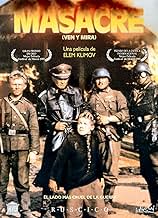After finding an old rifle, a young boy joins the Soviet resistance movement against ruthless German forces and experiences the horrors of World War II.After finding an old rifle, a young boy joins the Soviet resistance movement against ruthless German forces and experiences the horrors of World War II.After finding an old rifle, a young boy joins the Soviet resistance movement against ruthless German forces and experiences the horrors of World War II.
Aleksey Kravchenko
- Flyora Gayshun
- (as A. Kravchenko)
Olga Mironova
- Glasha
- (as O. Mironova)
Liubomiras Laucevicius
- Kosach
- (as L. Lautsyavichius)
Vladas Bagdonas
- Rubezh
- (as V. Bagdonas)
Jüri Lumiste
- Obersturmführer
- (as J. Lumiste)
Viktors Lorencs
- Sturmbannführer
- (as V. Lorents)
Kazimir Rabetsky
- Village Headman
- (as K. Rabetsky)
Evgeniy Tilicheev
- Gezhel
- (as E. Tilicheev)
Igor Gnevashev
- Yankel
- (as I. Gnevashev)
Vasiliy Domrachyov
- Little Policeman
- (as V. Domrachev)
Evgeniy Kryzhanovskiy
- Partisan with glasses
- (as E. Kryzhanovsky)
Viktor Manaev
- Partisan
- (as V. Manaev)
Takhir Matyullin
- Elderly partisan
- (as T. Matiulin)
Storyline
Did you know
- TriviaLive ammunition was used during filming. In interviews, Aleksey Kravchenko has described bullets passing 10 centimeters above his head.
- GoofsMany of the vehicles are post-World War II Soviet vehicles with slapped-on German Army markings.
- Quotes
Flyora Gaishun: To love... to have children...
- ConnectionsFeatured in Memória (1990)
- SoundtracksDie Walküre
Written by Richard Wagner
Featured review
Even before the final credits rolled, I strongly suspected this movie would end up on my Top 20; in fact, perhaps even my Top 10. A teenage boy, his hearing impaired from having just been at the site of a bombing, and a young woman clutching at him, the two of them stumbling and sludging through a slimy, smelly bog. A stork in the woods as it rains. A cluster of dolls piled up on the floor with flies buzzing all over the room. You don't need vast, elaborately choreographed battle scenes to bring home the message of the senselessness and pain of war. Reading viewers' comments on the movie, it seems that most found the second half which admittedly contained some of the most powerful massacre scenes ever filmed as the most "satisfying". A few other viewers seem to imply the movie doesn't really get going until the second half. For me, it was the first half that got under my skin the most, for its cinematic originality, poetry and symbolic power. War is experienced by civilians as well as by soldiers: this may seem like an obvious statement, but it's only after watching Come and See that you realise how few war movies are truly about the suffering of the ordinary man and woman, defenseless child and frail senior citizen. Also, never before had I seen the plight of raped women in war so powerfully conveyed, and all this without the movie ever being voyeuristic or graphic. In cinema, rape is often portrayed as something that looks like rough sex. It isn't always quite clear why women get so upset over it. In Come and See, rape is shown as nothing but pure, unadulterated, hate-fuelled violence with only a superficial, external resemblance to sex. Unlike other raped women on film, you cannot imagine those in Come and See ever healing from their scars.
On another subject, whoever thinks this movie contains "propaganda" is obviously prejudiced against the movie simply because it's a Soviet production, and should think things over a little more carefully. It's astonishing how you can still find little traces of the Cold War mentality surviving to this day, even in younger viewers... The fact that as detractors of Come and See claim, Stalin "was no better than Hitler" has nothing to do with anything at all, in this movie's context - Klimov's picture is NOT about nationalistic oneupmanship on who had the worst tyrant - it's about the basic suffering of ordinary humanity in war - ANY war, though this one happened to be going on in Bielorussia. There was in fact ten times more propaganda in ten minutes of Saving Private Ryan than the whole of Come and See. This is painful, sublime cinema. I've always believed there's something special about Russians when it comes to producing art, especially literature - this movie goes some way towards reinforcing that impression in me.
On another subject, whoever thinks this movie contains "propaganda" is obviously prejudiced against the movie simply because it's a Soviet production, and should think things over a little more carefully. It's astonishing how you can still find little traces of the Cold War mentality surviving to this day, even in younger viewers... The fact that as detractors of Come and See claim, Stalin "was no better than Hitler" has nothing to do with anything at all, in this movie's context - Klimov's picture is NOT about nationalistic oneupmanship on who had the worst tyrant - it's about the basic suffering of ordinary humanity in war - ANY war, though this one happened to be going on in Bielorussia. There was in fact ten times more propaganda in ten minutes of Saving Private Ryan than the whole of Come and See. This is painful, sublime cinema. I've always believed there's something special about Russians when it comes to producing art, especially literature - this movie goes some way towards reinforcing that impression in me.
- Asa_Nisi_Masa2
- May 2, 2007
- Permalink
- How long is Come and See?Powered by Alexa
Details
Box office
- Gross US & Canada
- $71,909
- Opening weekend US & Canada
- $16,053
- Feb 23, 2020
- Gross worldwide
- $20,929,648
Contribute to this page
Suggest an edit or add missing content

































